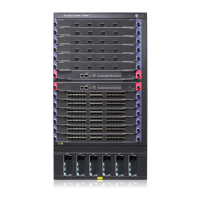112
Suppose the affinity of an MPLS TE tunnel is 0xFFFFFFFF and the mask is 0x0000FFFF. For a link to be
used by the tunnel, the leftmost 16 bits of its administrative group attribute can be 0s or 1s, but at least
one of the rest bits must be 1.
The affinity of an MPLS TE tunnel is configured at the first node on the tunnel and then signaled to the rest
of the nodes through RSVP-TE.
The associations between administrative groups and affinities may vary by vendor. To ensure the
successful establishment of a tunnel between two devices from different vendors, correctly configure their
respective administrative groups and affinities.
To configure the administrative group and affinity attribute:
Ste
Command
Remarks
1. Enter system view.
system-view
N/A
2. Enter interface view of MPLS
TE link.
interface interface-type
interface-number
N/A
3. Assign the link to a link
administrative group.
mpls te link administrative group
value
Optional.
The default is 0x00000000.
4. Exit to system view.
quit N/A
5. Enter MPLS TE tunnel interface
view.
interface tunnel tunnel-number N/A
6. Configure the affinity attribute
of the MPLS TE tunnel.
mpls te affinity property properties
[ mask mask-value ]
Optional.
The default affinity attribute is
0x00000000, and the default
mask is 0x00000000.
7. Submit current tunnel
configuration.
mpls te commit N/A
Configuring CR-LSP reoptimization
Dynamic CR-LSP optimization involves the periodic calculation of paths that traffic trunks traverse. If a
better route is found for an existing CR-LSP, a new CR-LSP is established to replace the old one, and
services are switched to the new CR-LSP.
To configure CR-LSP reoptimization:
Ste
Command
Remarks
1. Enter system view.
system-view N/A
2. Enter MPLS TE tunnel interface view.
interface tunnel tunnel-number N/A
3. Enable reoptimization for the MPLS TE
tunnel.
mpls te reoptimization [ frequency
seconds ]
Disabled by default.
4. Submit current tunnel configuration.
mpls te commit N/A
5. Return to user view.
return N/A
6. Perform reoptimization on all MPLS TE
tunnels with reoptimization enabled.
mpls te reoptimization Optional.

